Latest Film
Test Results - Updated
12/31/04
UPDATE 12/31/04: Results from
60-minute exposures of Fuji Super HQ200 film show it to be quite nice
for astrophotography. See below. Also, several of the
latest astro-photos on the main page
were taken with HQ200 and the results were excellent.
UPDATE 10/21/04: Latest
results are at top of table below, for Kodak Ultra Color 400 and Fuji
Super HQ 200. The Ultra Color is not good at all, and closely
resembles the results from the Kodak High Definition 400 tested
earlier. Could it be the same film?
The HQ200, however, is a VERY promising print film and warrants
some continued experimentation, particularly for results of exposures
of 45-60 minutes and longer.
I have recently tested a few "new and improved"
print films. The results are pretty interesting. When I
embarked on this mini-project (click
here to compare this page to my huge film-testing project from
summer/fall 2001), I expected to find nothing useful.
However, I am somewhat encouraged by the results below.
As you can see, to a film, none were at all good when viewed as "raw"
(unprocessed) scans. However, two films actually turned out
reasonably well when adjusted in Photoshop. I used the Levels and
Curves commands on the Konica Centuria Super 400 and the Kodak Max
Versatility Plus 800 and the results, as you can see below, are not bad
at all.
That said, I fear that, unless you have access to
a film scanner, your mileage will DEFINITELY be lower than this.
The unprocessed scans of the Kodak Max Versatility Plus 800 pretty well
matched what I got back from the film lab when the film was developed,
so the Photoshop adjustments certainly surprised me with how useable
they turned out to be. On the other hand, the unprocessed scan of
the Konica Centuria Super 400 shocked me, since the print I received
from the lab wasn't too bad and closely resembles my results after
applying Photoshop Levels and Curves adjustments.
So, anyway, here are the latest. I hope
this helps guide you as you seek decent astrophotography results in the
near future.
All test exposures below were taken using Olympus
OM-1 camera bodies at f/6.5 prime focus on a Meade LX200GPS 12".
All except the Kodak Ultra Color 400 and the Fuji Super HQ 200 were
taken at the Cincinnati Astronomy Society's dark-sky site in Adams
County, Ohio. Those most recent two were taken at Chiefland
Astronomy Village, in Florida.
| Notes |
|
| |
Fuji Super HQ 200 |
| Object: M20, the Trifid
Nebula. 20-minute exposure. Taken 10/15/04 at the Chiefland
Astronomy Village in Levy County, Florida. Seeing conditions were
4/5 darkness, 4/5 transparency, and 4/5 steadiness.
This print film produced a pretty exciting
result! Red response was very good and blue was pretty
respectable too. This film warrants considerably more
experimentation, particularly at longer exposures of, say, 45 or more
minutes.
|
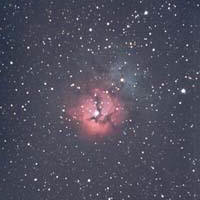 |
| |
Kodak Ultra Color 400 |
| Object: M20, the Trifid
Nebula. 20-minute exposure. Taken 10/15/04 at the Chiefland
Astronomy Village in Levy County, Florida. Seeing conditions were
4/5 darkness, 4/5 transparency, and 4/5 steadiness.
This film is obviously not acceptable for
astrophotography. It produced results somewhat similar to Kodak
High Definition 400 (below) in the raw scans, although this exposure
was adjusted in Photoshop a bit more than the HD400 in order to show
the level of detail captured.
|
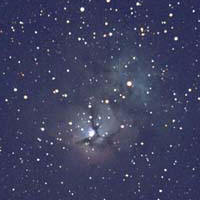 |
| |
"New" Fuji NPH 400 |
| Object: M20, the Trifid
Nebula. 20-minute exposure. Taken 6/28/03 at the Cincinnati
Astronomy Society's dark-sky site in Adams County, Ohio. Seeing
conditions were 4.5/5 darkness, 4/5 transparency, and 4/5 steadiness.
It was not possible (at least not easily,
so further attempts were abandoned) to salvage a useful shot from this
film.
Note: This is the "new" and
"improved" Fuji NPH 400. The older stuff was very good, but no
longer. Any package that says "New" on it is no good. You will
need to find the oldest stuff you can. There was a thread on APML a
couple of months back about how to tell the difference. Basically, if
the box has an expiration of "2003-8 127103" or older, it should be OK.
If it has "2004-7 113104" or newer, or if it says "New" on the box,
forget it.
Click
here to compare this exposure to the older, good version of Fuji
NPH 400 print film.
|
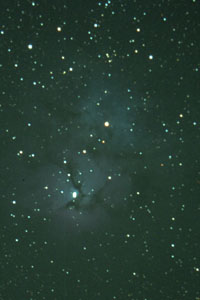 |
| |
Kodak High Definition
400
|
| Object: M20, the Trifid
Nebula. 20-minute exposure. Taken 6/28/03 at the Cincinnati
Astronomy Society's dark-sky site in Adams County, Ohio. Seeing
conditions were 4.5/5 darkness, 4/5 transparency, and 4/5
steadiness.
It was not possible (at least not easily,
so further attempts were abandoned) to salvage a useful shot from this
film.
|
 |
| |
Konica Centuria Super
400 - Unprocessed
|
Konica Centuria Super
400 - After Photoshop "Levels" and "Curves" Adjustments
|
| Object: M20, the Trifid
Nebula. 20-minute exposure. Taken 6/28/03 at the Cincinnati
Astronomy Society's dark-sky site in Adams County, Ohio. Seeing
conditions were 4.5/5 darkness, 4/5 transparency, and 4/5
steadiness. The adjusted print at far right matches the print
received from the film processing lab. The unprocessed scan at
left was a real surprise!
Notes regarding adjusted photo: the
blue response was definitely weak in this film, but it did at least
record a little. Red was not too bad.
|
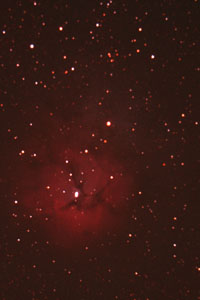 |
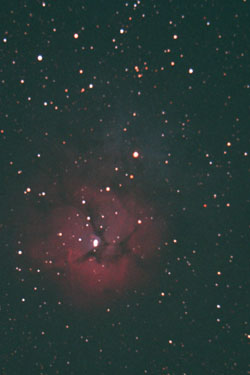 |
| |
Kodak Max Versatility Plus 800 -
Unprocessed (12 minute exposure)
|
Kodak Max Versatility Plus 800 -
After Photoshop "Levels" and "Curves" Adjustments (12 minute exposure)
|
| Object: M20, the Trifid
Nebula. 20-minute exposure. Taken 7/25/03 at the Cincinnati
Astronomy Society's dark-sky site in Adams County, Ohio. Seeing
conditions were 4.5/5 darkness, 4/5 transparency, and 4/5
steadiness. The unprocessed scan at left matches the print
received from the film processing lab and had a pronounced green
cast. The blue cast is still a touch overpowering in the adjusted
scan, but overall it isn't too bad. Grain was also acceptable. |
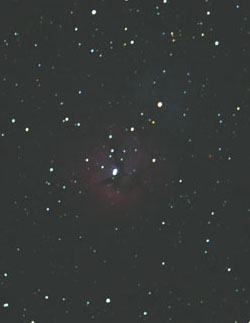 |
 |
| |
Kodak Max Versatility Plus 800 -
Unprocessed (24 minute exposure)
|
Kodak Max Versatility Plus 800 -
After Photoshop "Levels" and "Curves" Adjustments (24 minute exposure)
|
| Object: M20, the Trifid
Nebula. 20-minute exposure. Taken 7/25/03 at the Cincinnati
Astronomy Society's dark-sky site in Adams County, Ohio. Seeing
conditions were 4.5/5 darkness, 4/5 transparency, and 4/5
steadiness. The unprocessed scan at left matches the print
received from the film processing lab and had a pronounced green
cast. The blue cast didn't overpower the red quite as much in
this exposure as compared to the 12-minute exposure above. Grain
was also acceptable.
This longer exposure was made to test the
recording "stamina" of this film. There had been some conjecture
recently on APML that this film might not record much after 15 or 20
minutes. The comparison to the 12-minute exposures directly above
tend to indicate otherwise.
|
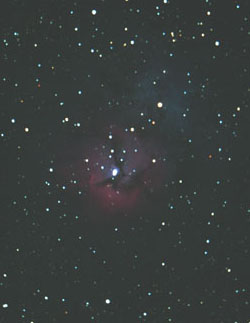 |
 |
Final Comments: I would probably recommend the
Kodak Max Versatility 800 Plus, but only if you have ready access to
photo-processing software like Photoshop, and some way to scan the
negatives. The Konica would be worth a little more investigation,
but Konica seems to be pretty difficult to find except via mail-order,
and I've never warmed up to that too much. On the other hand,
with the right relationship with your photo processing lab, you might
be able to coax them into color-correcting them for you. Straight
out of the box, however, I really cannot recommend any of these print
films. <sigh>,,,
Update 10/21/04: I am almost
ready to recommend the Fuji Super HQ200, as it proved to do a very nice
job on the test object, M20. I want to do some longer-exposure
experiments before I can recommend it unequivocably, however.
UPDATE 12/31/04:
Several 60-minute exposures on the Super HQ200 show that it is
excellent for astrophotography! See the many photos on the
main page that were taken at longer
exposures with this film.









